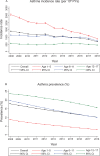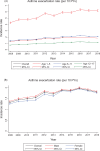Recent trends in asthma diagnosis, preschool wheeze diagnosis and asthma exacerbations in English children and adolescents: a SABINA Jr study
- PMID: 37524391
- PMCID: PMC10715559
- DOI: 10.1136/thorax-2022-219757
Recent trends in asthma diagnosis, preschool wheeze diagnosis and asthma exacerbations in English children and adolescents: a SABINA Jr study
Abstract
Background: Asthma-related burden remains poorly characterised in children in the UK. We quantified recent trends in asthma prevalence and burden in a UK population-based cohort (1‒17-year-olds).
Methods: The Clinical Practice Research Datalink Aurum database (2008‒2018) was used to assess annual asthma incidence and prevalence in 1‒17-year-olds and preschool wheeze in 1‒5-year-olds, stratified by sex and age. During the same period, annual asthma exacerbation rates were assessed in those with either a diagnosis of preschool wheeze or asthma.
Results: Annual asthma incidence rates decreased by 51% from 1403.4 (95% CI 1383.7 to 1423.2) in 2008 to 688.0 (95% CI 676.3 to 699.9) per 105 person-years (PYs) in 2018, with the most pronounced decrease observed in 1‒5-year olds (decreasing by 65%, from 2556.9 (95% CI 2509.8 to 2604.7) to 892.3 (95% CI 866.9 to 918.3) per 105 PYs). The corresponding decreases for the 6‒11- and 12‒17-year-olds were 36% (1139.9 (95% CI 1110.6 to 1169.7) to 739.9 (95% CI 720.5 to 759.8)) and 20% (572.3 (95% CI 550.4 to 594.9) to 459.5 (95% CI 442.9 to 476.4)) per 105 PYs, respectively. The incidence of preschool wheeze decreased over time and was slightly more pronounced in the 1‒3 year-olds than in the 4-year-olds. Prevalence of asthma and preschool wheeze also decreased over time, from 18.0% overall in 2008 to 10.2% in 2018 for asthma. Exacerbation rates increased over time from 1.33 (95% CI 1.31 to 1.35) per 10 PYs in 2008 to 1.81 (95% CI 1.78 to 1.83) per 10 PYs in 2018.
Conclusion: Paediatric asthma incidence decreased in the UK since 2008, particularly in 1-5-year-olds; this was accompanied by a decline in asthma prevalence. Preschool wheeze incidence also decreased in this age group. However, exacerbation rates have been increasing.
Keywords: Asthma Epidemiology; Paediatric asthma.
© Author(s) (or their employer(s)) 2023. Re-use permitted under CC BY-NC. No commercial re-use. See rights and permissions. Published by BMJ.
Conflict of interest statement
Competing interests: EM is an employee of AstraZeneca and owns stock in AstraZeneca. IS received consultancy from AstraZeneca to their institutions for this work. GR received consultancy from AstraZeneca to their institutions for this work. RJPvdV is an employee of AstraZeneca and owns stock in AstraZeneca and GlaxoSmithKline. JKQ reports grants from AUK-BLF and The Health Foundation; grants and personal fees from AstraZeneca, Boehringer Ingelheim, GlaxoSmithKline and Bayer; and grants from Chiesi, outside the submitted work. JKQ’s research group received funding from AstraZeneca for this work. TNT is an employee of AstraZeneca and owns stock in AstraZeneca. CK and ADM have nothing to declare.
Figures




References
-
- Global Initiative for Asthma . Global strategy for asthma management and prevention. 2022. Available: https://ginasthma.org [Accessed 8 Jun 2022].
-
- International Respiratory Coalition . Asthma. 2019. Available: https://international-respiratory-coalition.org/diseases/asthma/ [Accessed 8 Jun 2022].
-
- Asthma UK . Asthma facts and statistics. Available: https://www.asthma.org.uk/about/media/facts-and-statistics [Accessed 8 Jun 2022].
-
- The National Institute for Health and Care Excellence . Clinical knowledge summaries: asthma. Available: https://cks.nice.org.uk/topics/asthma/background-information/prevalence [Accessed 8 Jun 2022].
